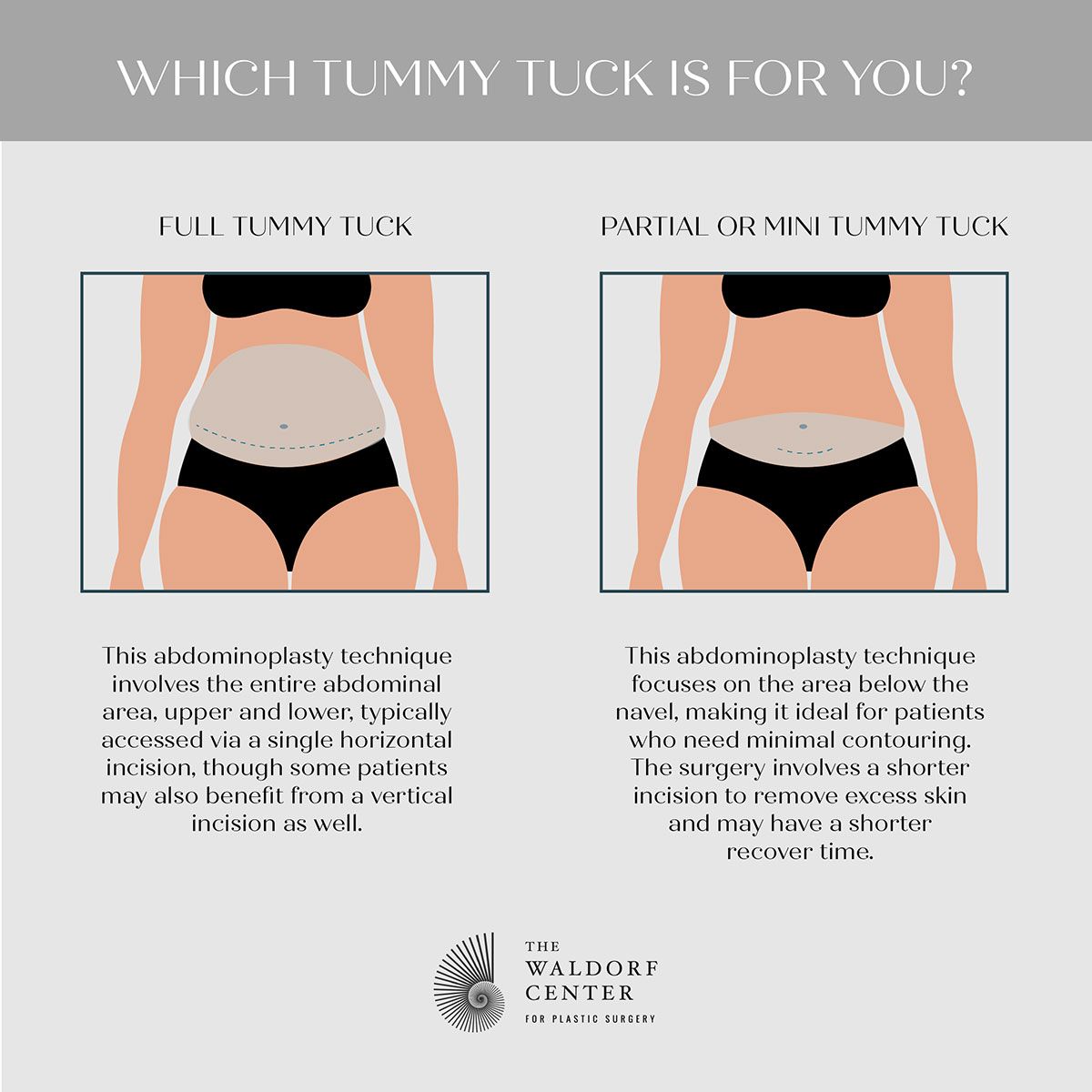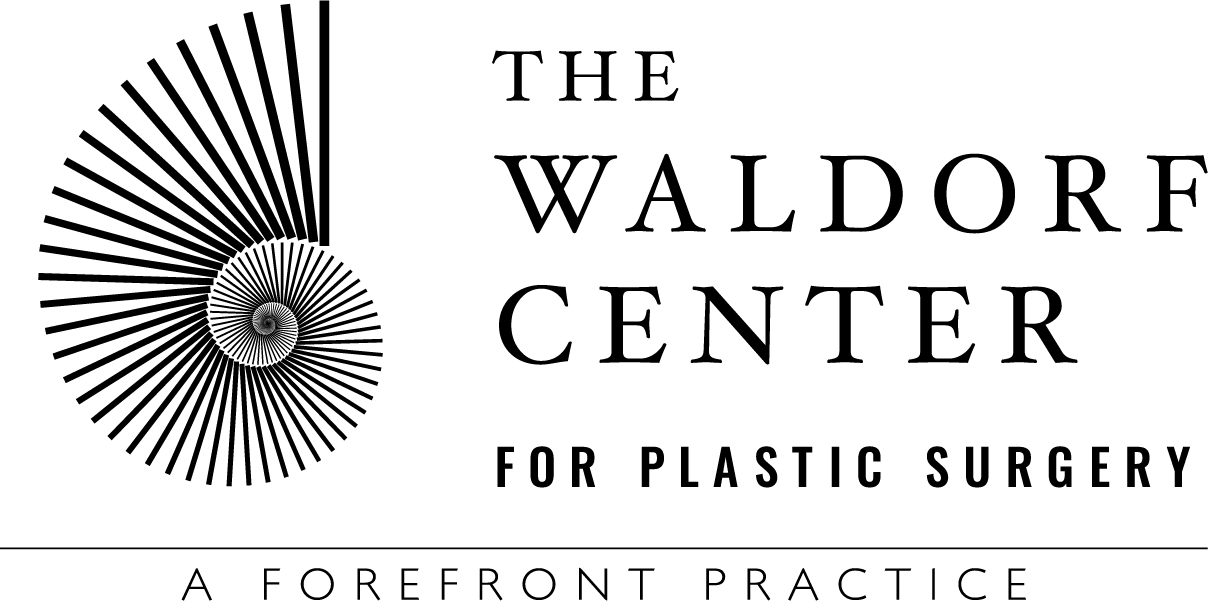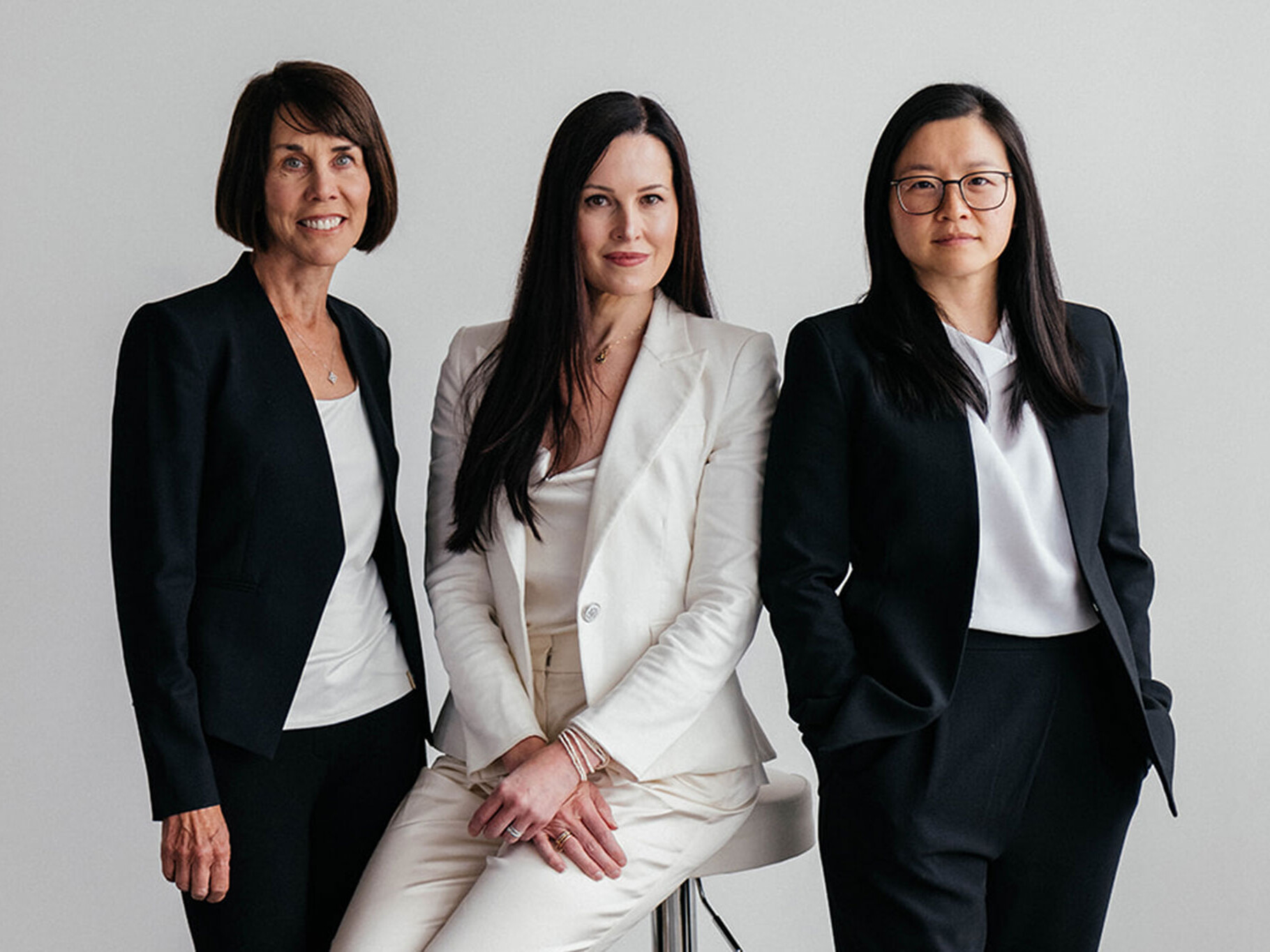- Home
- SURGERY
- Body Surgery
- Tummy Tuck
TUMMY TUCK
ACHIEVE A FIRMER, SLIMMER, AND MORE TONED
ABDOMINAL AREA AT OUR PORTLAND, OR PRACTICE
FAQS
A tummy tuck at Portland’s Waldorf Center is a transformative plastic surgery procedure designed to reshape and refine the appearance of the midsection. Also known as abdominoplasty, this surgery primarily involves the removal of excess skin and fat from the abdominal area, helping to create a smoother, flatter, and more toned contour. In many cases, the procedure also includes tightening of the underlying abdominal muscles that may have become stretched or weakened due to pregnancy, weight fluctuations, or aging. Whether you’re looking to restore your pre-pregnancy figure or improve body contours after weight loss, a tummy tuck with the most advanced techniques for 2025, 2026, and the future offers a highly effective cosmetic solution.
CONTACT US
Contact The Waldorf Center for Plastic Surgery to learn more about a tummy tuck in Portland, Oregon. Patients in the Vancouver and Salem areas and beyond can call 503-646-0101 or 1-800-310-7901. You can also inquire about a visit online.
WHAT ARE THE BENEFITS OF A TUMMY TUCK?
A tummy tuck is commonly performed on patients following bariatric surgery or as part of a post-pregnancy Mommy Makeover to remove loose, sagging tissue that no longer conforms to their slimmer shape. It’s also a popular option for male patients dealing with stubborn abdominal bulges—often referred to as a “spare tire” or “beer belly”—caused by aging, weakened abdominal muscles, and skin laxity that doesn’t improve with diet or exercise. When performed by a skilled, board-certified plastic surgeon, a tummy tuck can dramatically reshape and strengthen the abdominal area, enhancing the overall appearance of the body.
Benefits of a tummy tuck include:
- Flatter, more defined abdominal contours
- Tightening of weakened or separated abdominal muscles
- Removal of excess, sagging skin
- Improved posture due to stronger core support
- Increased comfort and confidence in clothing and swimwear
WHO IS A CANDIDATE FOR A TUMMY TUCK?
Lots of patients want to know, “Who is the best candidate for a tummy tuck?” or more specifically, “What weight should I be for a tummy tuck?” It’s worth noting that abdominoplasty surgery is not intended to achieve weight loss but is most suitable for people who are very near their ideal weight and dealing with loose, sagging belly skin, weakened abdominal muscles, and a small amount of stubborn fat that does not respond to diet or exercise efforts.
An ideal candidate for a tummy tuck, or abdominoplasty, is someone in generally good health who struggles with these concerns. This procedure is especially beneficial for individuals who have experienced significant weight loss or pregnancy, which can stretch and separate abdominal muscles and leave behind loose skin. Candidates should be at a stable weight, non-smokers, and have realistic expectations about the results. It’s also best for those who are not planning future pregnancies, as this could reverse the benefits of the surgery. Abdominoplasty surgery can be transformative, improving self-esteem and confidence.
LIPOSUCTION VS. TUMMY TUCK: HOW DO THEY COMPARE?
Are liposuction and a tummy tuck the same? Body contouring is a popular choice at The Waldorf Center for Plastic Surgery in Portland. Liposuction and abdominoplasty surgery are two of the most in-demand choices, as they provide significant results that can immediately slim down a person’s silhouette. Patients frequently have questions about one or both procedures, wondering what they have in common and what sets them apart.
TUMMY TUCK
A tummy tuck is not intended to be a fat-removal surgery, but it may include some liposuction. This is a smaller amount of fat than liposuction alone would remove. Since the main focus of abdominoplasty is removing loose skin, it can involve eliminating just the excess found below the navel or a larger amount spanning the entire abdomen. The surgery also frequently includes the doctor tightening abdominal muscles and supportive tissues that have been stretched out by large fat cells.
LIPOSUCTION
While liposuction is frequently used to remove fat from a patient’s abdomen, reducing a bulging belly or love handles to either side, that is not its only application. Liposuction is also ideal for eliminating fat deposits found on the: chin, neck, waist, hips, upper and lower back, arms and legs (knees, calves, and ankles), and the buttocks and thighs. Liposuction is strictly a fat-reduction procedure. It does not correct muscle laxity or loose skin present before or after the surgery.
While abdominoplasty can further enhance the results of liposuction, it is often employed to counter the sagging aftereffects of massive weight loss due to medical intervention, surgery, or simple diet and exercise. It can also help new mothers restore the contours of their pre-birth bodies by repairing the muscles stretched out by a growing baby.
For this reason, liposuction is recommended for patients who are already near their ideal weight and those who have healthy skin that can conform to the new, slimmer contours. Patients who are likely to find themselves with sagging, excess skin after their liposuction procedure may also want to consider a skin-tightening surgery.
WHAT WILL YOUR TUMMY TUCK CONSULTATION AT THE WALDORF CENTER INVOLVE?
The choice to have a tummy tuck is a serious and personal one. Before finalizing any decision, patients should educate themselves on all of the variables involved, seeking out reliable sources of accurate information. Finding the right physician, who has significant relevant experience in this specific type of surgery, is essential. A tummy tuck begins long before the day of the procedure itself, with patient education and thorough consultation with a plastic surgeon of choice.

For tummy tuck surgery, Portland’s Waldorf Center offers two variations: full and mini. A full abdominoplasty allows our plastic surgeons to contour the upper and lower portions of the abdomen by removing fat, excising excess skin, and repairing muscles. A mini abdominoplasty is for patients whose contouring goals are limited to the area below the navel. This allows for more focused results, as well as a less-involved procedure and shorter recovery period after. Contact us for a consultation so we can help you determine the ideal technique for you.
Our board-certified plastic surgeons at The Waldorf Center believe in the importance of tummy tuck candidates being well informed so that they can approach the procedure with an understanding of what it can and cannot achieve, as well as how to prepare before the surgery and what to expect from recovery afterward. A solid relationship with a trusted doctor is key, which is why communication and comfort are emphasized at The Waldorf Center.
Tummy tuck patients are encouraged to make their decision after their questions have been answered (including concerns about what to expect during their recovery period) and they feel confident that a tummy tuck with one of our plastic surgeons is the right choice for them. Physicians recognize that no two patients share identical goals for cosmetic surgery. During your consultation, the surgeon will examine your midsection, note your medical history and stats, and tell you what a tummy tuck can reasonably accomplish.
One of your concerns might be, “What do I need to prepare for a tummy tuck?” After your first visit with your plastic surgeon, there are a number of steps you may be asked to take in order to get yourself ready for surgery. To enjoy the best results from a tummy tuck, patients are advised to make themselves well aware of all of the steps involved. Our physicians recommend that you start planning strategically months in advance (some say a full six months is ideal) and follow all instructions for rigorous follow-up self-care to ensure the tummy tuck recovery process goes smoothly.
You might also be thinking, “What should you not do before a tummy tuck?” Our plastic surgeons also recommend that patients maintain a stable body weight in the months leading up to the tummy tuck surgery and avoid taking certain medications, such as anti-inflammatory drugs, to achieve optimal outcomes. Smoking is detrimental to the healing process, as the chemicals inhaled interfere with the supply of blood and oxygen to tissues throughout the body. Ceasing smoking is critical in the weeks leading up to and after the tummy tuck operation.
What does a tummy tuck involve? What does a tummy tuck consist of? These are important questions to ask if you’re considering abdominoplasty. A tummy tuck typically takes one to two hours, depending on how much skin needs to be removed and tightened and is performed in a hospital or outpatient facility. Most often, Waldorf Center patients spend one night recovering in our accredited surgery center before heading home.
Before the tummy tuck operation begins, a combination of medical treatments is administered to put the patients into a temporary, sleep-like state. This ensures their continued comfort by rendering them unable to feel pain.
For a tummy tuck, the curved, horizontally oriented or elliptical-shaped incision is generally low on the abdomen: below the belly button and near the pubic hairline. The resulting scar will stay hidden under most bathing suit bottoms and underwear. Excess skin and fat may be removed, and stretched-out or separated abdominal muscles are repaired as needed. In some cases, the belly button may be repositioned. Surgeons use skin adhesives, tapes, and sutures to close the wound.
Liposuction may also be performed in conjunction with a tummy tuck to remove any excess fat from the area. Depending on the concerns being addressed, a second incision may be made around the belly button to target skin, muscle, or fat in the upper abdomen.
The abdominoplasty procedure performed is unique to each patient and requires an expert eye and skilled assessment to consider which elements may be the appropriate combination to deliver the desired results.
WHAT ARE THE DIFFERENT TYPES OF TUMMY TUCKS?
The type of tummy tuck you undergo will depend on patient and surgeon preference, as well as factors such as individual body type, anatomy, skin quality, and the location of the excess skin and fat. There are two main variations of tummy tuck procedures: a classic or “full” abdominoplasty and a partial abdominoplasty (otherwise known as a mini tummy tuck). Another option that many patients benefit from is a fleur-de-lis tummy tuck.
A full tummy tuck encompasses the entire abdominal and navel area. It can be used to create a smooth profile while contouring both the upper and the lower abdomen.
Many women find that after pregnancy and childbirth, they develop lax skin and muscle in their lower abdomen. A mini tummy tuck may be all that is required for some patients to achieve their desired results, especially if they only need a small amount of contouring and their main concern is a flab that has accumulated below the navel. Unlike a standard tummy tuck, the mini version only addresses the lower abdominal area, removing its excess skin and tightening lower abdominal muscles. It requires less recovery time and results in less scarring than traditional tummy tuck surgery.
Patients who have experienced significant weight loss (whether with the assistance of bariatric surgery or otherwise) may opt to receive a fleur-de-lis tummy tuck. This procedure includes the typical lower abdominal incision along with a second one made vertically down the midsection to address lax abdominal tissue more comprehensively. The length of this second incision depends on the extent of correction required but typically does not extend above the breastbone. The belly button may also be repositioned to a more proportionate level on the abdomen.
THREE TALENTED DOCTORS
ONE FOCUSED MISSION
The experienced surgeons at The Waldorf Center for Plastic Surgery—Dr. Kathleen Waldorf, Dr. Rachel Streu and Dr. Heidi Johng—built the practice on a foundation of providing patients with high quality, ethical care. One of their guiding principles is a belief that cosmetic surgery is as much an art as it is a science.
The experienced surgeons at The Waldorf Center for Plastic Surgery—Dr. Kathleen Waldorf, Dr. Rachel Streu and Dr. Heidi Johng—built the practice on a foundation of providing patients with high quality, ethical care. One of their guiding principles is a belief that cosmetic surgery is as much an art as it is a science.
Dear Dr. Waldorf,
Thank you so very much for your outstanding job on my “tummy tuck!” I am so pleased with the results! You have an amazing skill, wonderful bed-side manner, super staff, beautiful office, and fabulous service to all of us women! I feel younger and more enthused to be healthy. I’ve been talking about you to my friends. You’ve made a difference in my life!
— 57-year-old female patient
*Patient testimonial. Results may vary
Getting the right aftercare plan in place is important for proper recovery. Recovery after tummy tuck surgery is relatively quick, and most patients find they are able to resume a regular work or home schedule after about two weeks of recuperation. Most can return to strenuous activity levels in about six weeks after surgery.*
The post-op period typically involves some bruising, soreness, and swelling. You may also find it hard to walk completely straight for the first few days. To lower the risk of infection, your physician may prescribe an antibiotic. You can take pain medication to manage any discomfort, but keep in mind that some mild residual swelling will remain for a few weeks to months. You can also expect the skin between the navel and the wound to feel numb. After these effects subside, the result is a flatter, firmer, smoother tummy and trimmer waistline.*
Your abdominal incisions are likely to be wrapped in surgical dressings or bandages to provide support and reduce swelling. In some cases, thin tubes or drains may be placed at the time of a tummy tuck to collect excess fluid as you heal, and you may be instructed to wear a compression garment for up to six weeks. If drains are used, they will be removed along with your sutures during a post-operative visit with your plastic surgeon.
During your recovery period, it is important to get enough rest and avoid positions that stretch or strain the fresh incisions or sutured abdominal muscles. Some patients have found that having supplies such as extra pillows, a body pillow, a recliner, ice packs, and gauze pads helps them to feel more comfortable and accelerates the healing process during this time.
As mentioned above, a tummy tuck is not a weight loss procedure and will not prevent patients from gaining weight in the future. Once your surgeon clears you to resume all activities, it is important to make habits of healthy eating and regular exercise to sustain the results of your tummy tuck long-term.
Special Financing Available
The Waldorf Center in Portland, OR, offers special financing for the recommended surgical or non-surgical procedure you want. Convenient monthly payments can be structured to fit your financial situation. Call the practice for more information at 503-646-0101 or contact us online.
As mentioned earlier, liposuction is often included as part of a tummy tuck procedure, but it can also be performed on its own to remove stubborn fat from various areas of the body—including the abdomen, buttocks, thighs, and even under the chin to address a double chin. In some cases, your plastic surgeon may recommend liposuction as an alternative to a tummy tuck if you have localized fat deposits in the abdominal area but little to no excess or loose skin.
For patients who have lost a significant amount of weight, loose, hanging skin may also be present in other areas of the body. In these cases, additional body contouring procedures can help restore a smoother silhouette. An arm lift focuses on tightening sagging skin in the upper arms, while a thigh lift or a full lower body lift can address excess tissue in the hips, thighs, and buttocks.
While there’s no true non-surgical alternative that can fully replicate the results of a tummy tuck, there are several non-invasive treatments available that can help contour the body for patients who don’t need or want surgery. These options won’t deliver the same dramatic or comprehensive improvements as a tummy tuck—especially when it comes to removing loose skin or tightening weakened abdominal muscles—but they can still be effective for reducing small areas of fat and enhancing muscle tone.
One such treatment is EMSCULPT®, which uses high-intensity focused electromagnetic energy to stimulate thousands of powerful muscle contractions in a single session. This process helps strengthen and tone the muscles while also reducing fat in targeted areas like the abdomen and buttocks. CoolSculpting® is another popular non-invasive option that freezes and eliminates fat cells in problem areas, while Emtone® helps smooth cellulite and improve skin texture by combining radiofrequency and mechanical energy. These treatments can be great choices for individuals seeking subtle improvements without the downtime of surgery.
Contact The Waldorf Center for Plastic Surgery if you would like to schedule a consultation for a tummy tuck in Portland, Oregon. Inquire online or call our practice directly at 503-646-0101, and we will be happy to answer any questions you may have.
*Patient results may vary*









